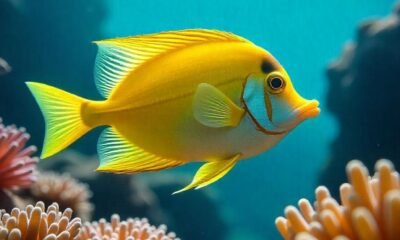EDUCATION
How Many Teeth Does a Shark Really Have?

Sharks, the ancient apex predators of the ocean, inspire awe and curiosity—especially when it comes to their formidable dentition. How many teeth does a shark really have? Unlike humans, whose 32 teeth serve a lifetime, sharks boast a vastly different dental arrangement
The Anatomy Behind a Shark’s Teeth
Shark teeth are anchored in the gums, not bone, which gives them flexibility but also necessitates rapid replacement. The rows of teeth are supported by fibrous tissue, allowing for perpetual tooth regeneration. This biological marvel means that when a tooth is lost, another rolls forward from the multiple rows behind. Not only are these teeth sharp, but they are also perfectly suited to each species—cutting, crushing, or grasping, depending on the shark’s diet.

Diversity Across Species
Shark species exhibit remarkable diversity, with dental structures tailored to their ecological niches:
- Great white sharks possess large, serrated triangular teeth, ideally suited for slicing through tough-skinned prey.
- Tiger sharks feature broad, serrated teeth, enabling them to cut through turtle shells and marine debris.
- Nurse sharks, on the other hand, use flatter, molar-like teeth to crush crustaceans and mollusks.
- Goblin sharks, a rare deep-sea species, have needle-like teeth that thrust forward to snag soft-bodied prey.
These morphological distinctions reflect the evolutionary pressure each species faces in capturing and consuming food.
How Many Teeth Are in a Shark’s Mouth at Once?
While the total number of teeth a shark may produce during its lifetime can reach into the tens of thousands, the number actively deployed in its mouth is far more modest. Typical jaw arrangements include:
- Tiger shark – Around 48 upper and 36 lower teeth.
- Great white shark – Approximately 50 rows in each jaw, with 5–7 teeth per row.
- Bull shark – Approximately 50 upper and 50 lower teeth visible at any given time.
These rows move into place like a conveyor belt, ensuring that a shark always has a full set of functional teeth ready for action.
The Shark Tooth Replacement Cycle (Ever-Growing Teeth)
One of the most fascinating features of shark dentition is continual replacement. Sharks produce multiple sets of teeth through three developmental phases:

- Initial tooth buds form in the embryonic stage.
- As sharks grow, new teeth develop in multiple rows behind the active set.
- When a front tooth is lost—whether from biting into prey or wear and tear—it is replaced by a tooth from the row behind.
The rate of tooth replacement varies widely among species and depends on factors like age, diet, and environmental conditions. Some shark species can replace a tooth in as little as 24 to 48 hours, with an estimated pace of 35,000 teeth over a lifetime in certain species.
Why Do Sharks Continuously Shed Teeth?
Sharks’ tooth replacement is driven by several evolutionary imperatives:
- Dietary demands: Constant feeding on tough or abrasive prey—like fish, seals, or turtles—leads to wear, breakage, or loss of teeth.
- Hunting strategy: To bite effectively and maintain grip, sharks must always have a functional complement of teeth.
- Adaptive advantage: Rapid replacement ensures that sharks remain lethal predators, with minimal downtime due to dental incapacitation.
This efficient dental renewal supports sharks’ predatory edge and reduces their vulnerability during feeding.
Shark Teeth in Paleontology and Fossil Records
In paleontological studies, shark teeth are far more common fossils than their skeletal remains due to their durable enamel. Each fossil tooth serves as a snapshot of the evolutionary history of sharks:
- Megalodon teeth—up to 7 inches wide—reveal an ancient shark with unmatched size and power.
- Smaller fossil teeth from ancient species provide clues about evolutionary lineage, diet shifts, and migration patterns over millions of years.
Fossilized shark teeth are prized by scientists and collectors alike, offering invaluable insights into the prehistoric marine environment.
The Role of Shark Teeth in the Marine Ecosystem
Shark teeth aren’t just tools—they’re cornerstones of marine ecology. By enabling sharks to predate on various species, they:
- Regulate prey populations, ensuring ecological balance.
- Scavenge carcasses, contributing to nutrient cycling.
- Support symbiotic relationships, like those with remora fish that hitch rides on sharks.
Each tooth, therefore, plays a part in sustaining oceanic biodiversity and ecosystem resilience.
How Scientists Study Shark Teeth
Marine biologists and paleontologists employ diverse methods to investigate shark dentition:
- Field observations: Monitoring tooth replacement rates in live captive specimens or wild sharks tagged for study.
- CT imaging and 3D modeling: Revealing internal structures and predicting tooth growth patterns.
- Chemical analysis: Investigating enamel and dentine composition to understand feeding ecology.
- Fossil excavations: Collecting and categorizing teeth for evolutionary timelines.
These multidisciplinary techniques have helped paint a thorough picture of why sharks evolved such remarkable dental systems.
FAQs
1. How often do sharks lose teeth?
Depending on species and diet, sharks may lose and replace a tooth anywhere from every few weeks to as frequently as daily.
2. Can a shark go without teeth?
Not for long. Tooth loss reduces hunting effectiveness, prompting rapid adoption of a replacement tooth from the posterior rows.
3. Are all shark teeth the same shape?
No—there’s significant variation. Serrated, triangular teeth are ideal for tearing flesh, whereas flat, crushing teeth handle shelled prey.
4. How do scientists tell shark species apart using fossil teeth?
Each shark species has distinctive tooth morphology—shape, size, serration pattern—allowing precise identification through fossil dentition.
5. Do female sharks have more teeth than males?
No, tooth count is generally similar across sexes of the same species, though size and robustness may vary slightly.
Conclusion
Sharks possess a multitude of teeth at any given time, numbered in the dozens, but their lifelong capacity to grow tens of thousands more sets them apart from nearly every other predator. This remarkable tooth regeneration system—driven by specialized dental morphology and anchored in evolutionary necessity—allows sharks to remain effective hunters throughout their lives. From fossilized specimens that illuminate ancient lineages to real-time studies revealing continuous renewal, shark teeth remain a compelling subject of study

TECH
What Is the Windows Security Button? A Complete Guide for Tablet and PC Users

When using certain Windows tablets and 2-in-1 devices, you may have noticed prompts that say: “Press Ctrl+Alt+Delete or use the Windows Security Button.” For many, this can feel confusing, especially if the device doesn’t have a traditional keyboard. The Windows Security Button exists to replicate the same secure login process as pressing the famous Ctrl+Alt+Delete key combination on a regular computer. It ensures safe authentication and quick access to essential system functions, making it a crucial feature in Microsoft’s security ecosystem.

Understanding the Secure Attention Sequence (SAS)
To grasp why this feature exists, we first need to explore the concept of the Secure Attention Sequence (SAS). Introduced in early versions of Windows, SAS is the technical term for pressing Ctrl+Alt+Delete.
The purpose of this sequence is security. It’s a hardware-level command that cannot be intercepted by malicious software. By requiring users to press it before logging in, Windows ensures the login screen is authentic and not a spoof created by malware. This measure prevents password theft and protects user accounts from unauthorized access.
On desktop PCs with physical keyboards, triggering SAS is simple. But on tablets and devices without a keyboard, Microsoft had to introduce an alternative method—the Windows Security Button.
Why Tablets Need a Security Button
Modern computing devices are becoming slimmer, portable, and often designed without permanent keyboards. Tablets, convertibles, and touch-only laptops make portability easier but complicate traditional security controls.
Without a keyboard, pressing Ctrl+Alt+Delete isn’t always possible. To bridge this gap, manufacturers included a dedicated hardware feature or button combination that mimics the Secure Attention Sequence. This replacement makes sure that tablet users enjoy the same protection as desktop users, maintaining consistency across devices.

How the Security Button Works
The security button doesn’t perform any new magic—it simply tells Windows to trigger the same secure action that Ctrl+Alt+Delete would. Once pressed, the device presents the familiar Windows Security screen with options like:
- Lock the computer
- Switch User
- Sign Out
- Change Password
- Open Task Manager
This menu is especially useful in corporate and multi-user environments. For instance, employees can quickly lock their tablet when stepping away, while IT staff can access Task Manager to monitor processes without signing out.
Location and Activation Across Devices
The placement of this button varies depending on the manufacturer.
- Acer tablets often use a special Windows hardware key in combination with the Power button.
- Lenovo ThinkPad and Miix devices typically require pressing the Windows logo key together with the Power button.
- Some Surface models allow users to enable an on-screen equivalent through the ease-of-access settings.
This variability can confuse new users, which is why many system prompts remind you of both options: “Press Ctrl+Alt+Delete or use the Windows Security Button.”
Everyday Scenarios Where It Matters
The importance of this feature goes beyond logging in. Here are practical ways it improves daily computing:
1. Enhanced Security in Public Spaces
If you’re using a tablet in a café or coworking hub, a quick tap of the button lets you lock the screen before walking away. This protects sensitive files from prying eyes.
2. Simplified Multi-User Switching
In households or schools where devices are shared, users can easily switch accounts without restarting. The button provides fast access to the Switch User function.
3. Fast Access to Task Manager
When an application freezes on a tablet without a physical keyboard, opening Task Manager can feel tricky. Using the button provides a straightforward solution without relying on shortcuts.
Windows Security Button vs. Ctrl+Alt+Delete
Both options ultimately serve the same purpose—triggering the Secure Attention Sequence. However, their usage differs depending on the type of device:
| Feature | Ctrl+Alt+Delete | Security Button |
|---|---|---|
| Availability | Requires keyboard | Found on tablets/2-in-1 devices |
| Input Method | Three-key press | Physical button or key combo |
| Functions Provided | Lock, Switch User, Task Manager, etc. | Lock, Switch User, Task Manager, etc. |
| Security Level | Hardware-level | Equivalent, hardware-driven |
This shows that the button isn’t a replacement—it’s simply an adaptation for portable form factors.
Troubleshooting: When the Button Doesn’t Work
Some users report situations where pressing the button doesn’t seem to trigger the Windows Security screen. If this happens, try the following:
- Check Device Manuals – Each manufacturer uses different button combinations. Ensure you’re pressing the correct keys.
- Use On-Screen Alternatives – If hardware input fails, use the on-screen keyboard to press Ctrl+Alt+Delete.
- Update System Drivers – Outdated firmware or system drivers may interfere with hardware functions.
- Fallback Options – In corporate environments, IT admins can disable the requirement for SAS, though this is not recommended for personal security.

Best Practices for Secure Usage
- Always lock your screen when stepping away, especially in shared or professional environments.
- Use the button as a quick gateway to Task Manager instead of forcing a reboot when apps freeze.
- If your device lacks the feature, consider enabling on-screen SAS input in Windows accessibility settings.
- Keep your device updated—security patches ensure the SAS system remains reliable.
FAQs
What exactly does the Windows Security Button do?
It triggers the Secure Attention Sequence, which brings up the Windows Security screen with options like Lock, Switch User, Sign Out, Change Password, and Task Manager.
Where is the Windows Security Button located?
Its location depends on the manufacturer. Some tablets use a combination like the Windows key + Power button, while others may have a dedicated physical key.
Is the button available on all devices?
No. Desktops and laptops with physical keyboards usually rely on Ctrl+Alt+Delete. The button is more common on tablets and hybrid devices.
Can I disable the Secure Attention Sequence requirement?
Yes, system administrators can disable the need for SAS before login, but it reduces security and isn’t recommended for personal use.
What happens if the button doesn’t work?
You can use the on-screen keyboard to press Ctrl+Alt+Delete, check for driver updates, or consult your device manual for the correct key combination.
Why does Windows still require Ctrl+Alt+Delete or its equivalent?
Because it’s a secure, hardware-level signal that prevents malware from creating fake login screens to steal passwords.
Conclusion
The Windows Security Button may seem like a mysterious extra feature at first, but its purpose is clear: to provide tablet and hybrid device users with the same protection and convenience as traditional keyboard shortcuts. By replicating the Secure Attention Sequence, it ensures secure logins, quick access to system management tools, and an easy way to lock or switch users.
EDUCATION
Best Fintechzoom.io Courses for Students and Graduates

The fintech industry is evolving faster than ever, blending finance with advanced technologies like blockchain, AI, and digital banking. Whether you’re a finance professional, student, trader, tech enthusiast, or an entrepreneur, staying ahead means building the right skills. This is where fintechzoom.io courses come in.
These programs are designed to provide practical knowledge in areas like crypto trading, investment strategies, and blockchain innovation. But how do you know if these courses are the right fit? Let’s break it down.
Why Choose Fintechzoom.io Courses?
Fintechzoom.io has built a reputation as a specialized fintech learning platform. Unlike general e-learning sites, it focuses solely on financial technology, giving learners a competitive edge.
- Focused curriculum: Tailored for finance and technology professionals.
- Hands-on skills: Courses emphasize real-world case studies and applications.
- Flexibility: Designed for busy learners with self-paced modules.
- Community support: Access to fintech experts and peer groups.
Types of Fintechzoom.io Courses
Fintechzoom.io Training Programs
Fintechzoom.io training spans multiple finance and technology domains:
- Blockchain Education: Learn distributed ledger technology and its applications in banking.
- Crypto Courses: Understand Bitcoin, Ethereum, trading strategies, and regulations.
- Investment Training: Master portfolio management, risk analysis, and digital assets.
- Financial Courses: Explore payment systems, digital wallets, and banking innovation.

Course Formats
- Online Learning: 100% digital delivery with interactive tools.
- Classes & Workshops: Live sessions for deeper engagement.
- Certification Programs: Verified credentials for career advancement.
Key Features of Fintechzoom.io Learning Platform
| Feature | Benefit for Learners |
|---|---|
| Resealable learning modules | Pick up where you left off anytime. |
| Certification | Gain recognition in fintech and blockchain careers. |
| Expert-led courses | Taught by professionals with industry experience. |
| Global accessibility | Available to students and professionals worldwide. |
| Career pathways | Tailored programs for finance, tech, and investment roles. |
What Makes Fintechzoom.io Certification Valuable?
Certifications from fintechzoom.io carry weight in the job market. Employers look for candidates who show initiative in mastering digital finance. Completing a certification demonstrates:
- Knowledge of cutting-edge fintech tools.
- Ability to apply concepts like blockchain in practical settings.
- Commitment to professional growth.
According to the World Economic Forum, fintech-related jobs are among the fastest-growing global career paths (WEF Future of Jobs Report, 2023).
Fintechzoom.io Courses vs Other Platforms
| Platform | Focus Area | Unique Feature |
|---|---|---|
| Fintechzoom.io | Fintech, crypto, blockchain | Specialized financial technology training |
| Coursera | Broad subjects | Partnerships with universities |
| Udemy | Mixed topics | Affordable beginner-friendly courses |
| edX | Academic courses | University-backed certifications |
Fintechzoom.io stands out as a dedicated fintech platform, whereas others spread across general subjects.
Expert Perspectives
- Harvard Business Review emphasizes that fintech education helps professionals adapt to digital transformation in finance (HBR, 2023).
- PwC’s Global FinTech Report notes that over 80% of financial institutions invest in fintech training for staff (PwC, 2022).
- World Economic Forum highlights fintech as a top career field of the future (WEF, 2023).
These sources validate the authoritativeness of pursuing fintech education.
Conclusion
Fintech isn’t just the future—it’s the present. Whether you’re aiming for a finance role, tech position, or entrepreneurial journey, fintechzoom.io courses provide the specialized knowledge you need. With flexible online learning, industry-recognized certifications, and programs ranging from crypto to investment, this platform helps you stay ahead in an evolving industry.
FAQ’s
What is the fintechzoom.io learning experience like?
Interactive, flexible, and built for real-world applications.
Which fintechzoom.io courses cover crypto and trading?
Dedicated crypto courses and investment training programs focus on these areas.
Does fintechzoom.io offer financial technology career paths?
Yes. Courses are structured to prepare learners for fintech, investment, and blockchain careers.
Reviews of fintechzoom.io fintech certification programs?
Students often highlight the hands-on approach, expert-led modules, and career relevance.
Are fintechzoom.io courses accredited or industry recognized?
They are industry-recognized but not formally accredited by universities.
How long does it take to complete a fintechzoom.io program?
Depending on the course, completion can take anywhere from a few weeks to several months.
-

 TECH5 months ago
TECH5 months agoGlow and Type: Exploring Light-Up Computer Keyboards
-

 BUSINESS5 months ago
BUSINESS5 months agoChoosing the Perfect Salmon Fishing Pole
-

 BUSINESS5 months ago
BUSINESS5 months ago2025 Toyota Fortuner: The Ultimate Blend of Power and Luxury
-

 FOOD5 months ago
FOOD5 months agoLiquid Gold: The Science and Soul of Cooking Oil
-

 FOOD5 months ago
FOOD5 months agoYellowtail Unveiled: The Golden Jewel of the Sea
-

 BUSINESS5 months ago
BUSINESS5 months agoBussin’ with the Boys: New Contract, Same Chaos
-

 ENTERTAINMENT5 months ago
ENTERTAINMENT5 months agoLububu: The Viral Whirlwind of Digital Affection
-

 ENTERTAINMENT4 months ago
ENTERTAINMENT4 months agoBlades & Grit: Men’s Ice Skates